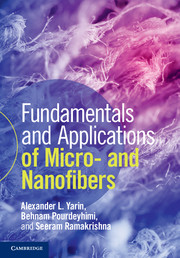Book contents
- Frontmatter
- Contents
- Preface
- 1 Introduction
- 2 Polymer physics and rheology
- 3 General quasi-one-dimensional equations of dynamics of free liquid jets, capillary and bending instability
- 4 Melt- and solution blowing
- 5 Electrospinning of micro- and nanofibers
- 6 Additional methods and materials used to form micro- and nanofibers
- 7 Tensile properties of micro- and nanofibers
- 8 Post-processing
- 9 Applications of micro- and nanofibers
- 10 Military applications of micro- and nanofibers
- 11 Applications of micro- and nanofibers, and micro- and nanoparticles: healthcare, nutrition, drug delivery and personal care
- Subject Index
- References
3 - General quasi-one-dimensional equations of dynamics of free liquid jets, capillary and bending instability
Published online by Cambridge University Press: 05 June 2014
- Frontmatter
- Contents
- Preface
- 1 Introduction
- 2 Polymer physics and rheology
- 3 General quasi-one-dimensional equations of dynamics of free liquid jets, capillary and bending instability
- 4 Melt- and solution blowing
- 5 Electrospinning of micro- and nanofibers
- 6 Additional methods and materials used to form micro- and nanofibers
- 7 Tensile properties of micro- and nanofibers
- 8 Post-processing
- 9 Applications of micro- and nanofibers
- 10 Military applications of micro- and nanofibers
- 11 Applications of micro- and nanofibers, and micro- and nanoparticles: healthcare, nutrition, drug delivery and personal care
- Subject Index
- References
Summary
This chapter introduces the fundamental general equations of the dynamics of free liquid jets in Sections 3.1 and 3.2. The applications of these equations encompass practically all fiber-forming processes from melt spinning, as was sketched out in Section 1.2 in Chapter 2 to melt- and solution blowing, and electrospinning of polymer micro- and nanofibers discussed in detail in Chapters 4 and 5, or drawing of optical fibers outlined in Section 6.5 in Chapter 6. They also form the framework for description of several types of instabilities characteristic of the hydrodynamics of free liquid jets in general and of fiber-forming processes in particular. These include capillary instability (Section 3.3), aerodynamically driven bending instability (Section 3.4) and buckling of liquid impinging onto a wall (Section 3.5).
Mass, momentum and moment-of-momentum balance equations
The dynamics of free liquid jets moving in air, which are characteristic of fiber-forming processes, involve growth of various perturbations. The most notable are driven by surface tension and the dynamic interaction with the surrounding air, as well as electrically driven effects. Theoretical/numerical description of the jet evolution in general, and of perturbed jets in particular, is hindered by the fact that such problems typically involve a three-dimensional, time-dependent evolution of flows with free surfaces, the locations in time of which should also be established. Solving such problems in the framework of the rigorous equations of fluid mechanics, say the Navier–Stokes equations, in most cases would be prohibitively time-consuming, even using super-computers. Additional complicating factors arise due to the rheological complexity of polymer solutions used in fiber forming, as well as the temperature-dependent variation of material properties in nonisothermal situations. Accounting for all these factors together in the framework of the rigorous equations of non-Newtonian fluid mechanics would be tremendously difficult. However, these difficulties can be relatively easily overcome in the framework of a quasi-one-dimensional description of liquid motion in the bending jets. In the works of Entov and Yarin (1980, 1984a) and Yarin (1983, 1993) the general quasi-one-dimensional equations of the straight and bending jets were derived from the integral balances of mass, momentum and moment of momentum, as well as by averaging the three-dimensional equations of hydrodynamics over the jet cross-section.
- Type
- Chapter
- Information
- Fundamentals and Applications of Micro- and Nanofibers , pp. 63 - 88Publisher: Cambridge University PressPrint publication year: 2014

